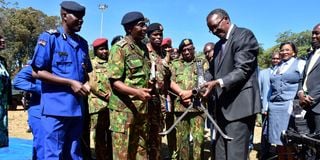Police want better perks and withdrawal of new uniforms

National Task Force on Improvement of the Terms and Conditions of Service and Other Reforms of the National Police Service and Kenya Prisons Service chairperson David Maraga (second right)during the start of the nationwide public participation exercise at the Bomas of Kenya in Nairobi yesterday.
Police have demanded the withdrawal of a fleet of Armoured Personnel Carriers (APCs) that are reportedly substandard and unable to offer sufficient protection.
They also want the new uniforms scrapped and salaries and allowances increased to match those for other security organs, according to their submissions to the task force on police and prison reforms that is chaired by former Chief Justice David Maraga.
The officers also want their allowances pegged on their ranks as opposed to the region of deployment and the duration of their training increased from nine to 12 months.
These are some of the proposals made by the National Police Service to the 23-member task force appointed by President William Ruto in December to look into the welfare of police and prison officers in the country.
The task force is expected to draft recommendations for improving officers’ terms and conditions of service. It is also expected to identify legal, policy, institutional and operational constraints that hinder effective delivery of service by police and prisons officers.
The recommendations made by the task force will be based on oral and written submissions received from relevant agencies, individual officers and members of the public. Before making their oral submissions to the task force on Monday, a technical team led by Inspector General of Police Japhet Koome police showcased some of the equipment and weapons that are in need of upgrading.
The team revealed that the 40 APCs should be replaced with100 Mine-Resistant Ambush Protected (MRAP) vehicles that provide greater protection to officers responding to banditry and terror threats in the insecurity prone regions of Northern Kenya.
MRAPs are superior and designed to protect users from Improvised Explosive Device (IEDs) .
Modern MRAPs are also suited with gun detection, heavy armour and communication systems. Currently, the service depends on APCs and modified Toyota Land Cruisers, which lack bullet proofing, gun detection systems and other technologies needed to enhance visibility, mobility and communication during operations. The team said the service has been struggling with replacing and repairing APCs that get hit by IEDs due to lack of funds as spare parts are not locally available.
Justice Maraga noted that the presentation of the equipment was an eye opener to the constraints felt by police officers while on duty, adding that notable issues submitted on officers’ welfare so far range from salaries and allowances to challenges with health insurance.
To ensure that its recommendations are implemented, the task force will create a strict timetable for use by the relevant state agencies effecting the changes.
“Once we finish with the recommendations, we are supposed to come up with an implementation matrix where we will say that this needs to be done by this body and we will give them time frames. If it is something touching on salaries, we will make recommendations to the salaries commission and give them timelines,” said Dr Maraga. On uniforms, officers want the Persian blue kits replaced with the Ethiopian uniform consisting of navy blue skirts and trousers and light blue shirts for general duty officers while Administration Police will retain their uniform.
They also want the new General Service Unit (GSU) combat gear gazetted and solely worn by GSU personnel, same as those worn by the Special Operations Group personnel, as National Government Administration Officers stick to their designated uniform.
Each service will be required to make its own memorandum to the task force ahead of the kick off of countrywide forums next week when the task force will visit social halls and police stations across the 47 counties to collect proposals from members of the public and individual officers.
Views collected from officers will be recorded anonymously to protect them from victimisation.





